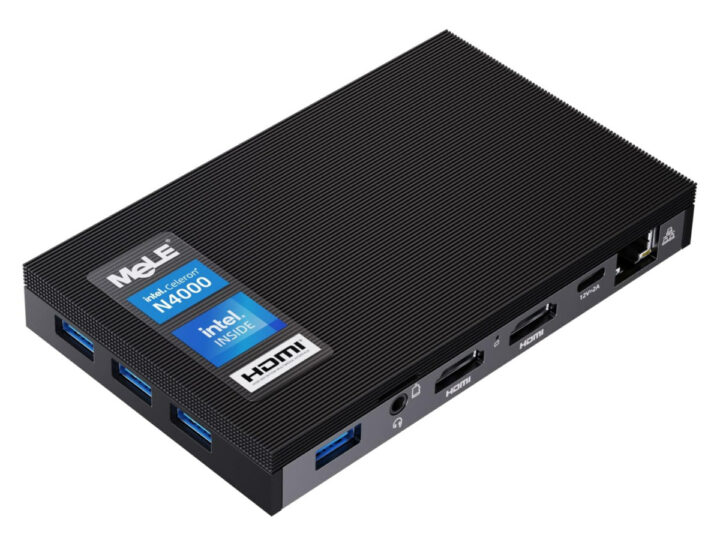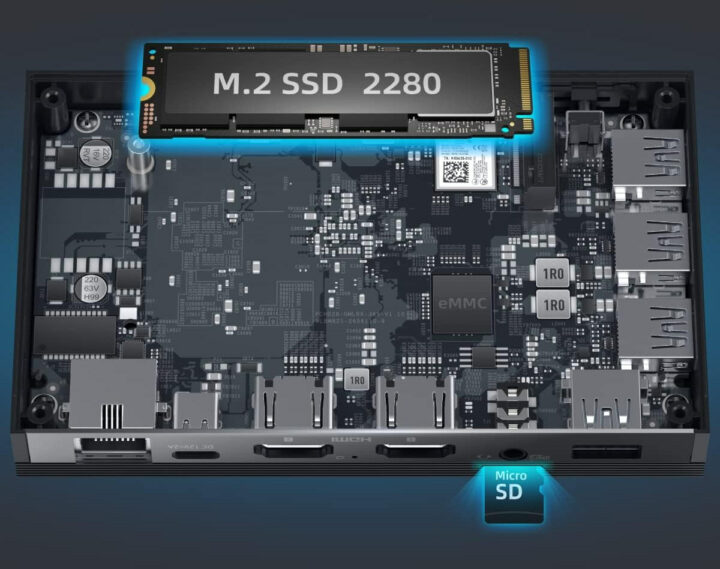Barring barebone models, most mini PCs sell with Windows 10 or Windows 11 pre-installed, and that’s not ideal for people wanting to run Linux only since they also pay extra for the license of an operating system they are not going to use. But MeLE is now selling the Quieter2D mini PC with an Intel Celeron N4000 dual-core processor, 4GB RAM, and 64GB or 128GB eMMC storage for $139.99 and up without an operating system or a Windows key.
The ultrathin fanless mini PC also features M.2 2280 SATA/NVMe socket, a microSD card reader, two HDMI 2.0 ports, Gigabit Ethernet and WiFi 5 connectivity, four USB 3.0 ports, and takes 12V power input through a USB Type-C port.
MeLE Quieter2D specifications:
- SoC – Intel Celeron N4000 dual-core Gemini Lake processor @ 1.1GHz / 2.6GHz (Turbo) with Intel UHD Graphic 600; 6W TDP
- System Memory – 4GB LPDDR4
- Storage – 64GB or 128 GB eMMC flash, M.2 2280 SATA/NVMe socket, MicroSD card reader
- Video Output – 2x HDMI 2.0 ports up to 4Kp60 Hz
- Audio – 3.5mm headphone+mic jack, digital audio output via HDMI
- Connectivity – Gigabit Ethernet RJ45 port, dual-band 802.11b/g/n/ac WiFi 5, and Bluetooth 4.2
- USB – 4x USB 3.0 ports
- Misc
- Power Button
- CMOS reset pinhole
- Kensington lock slot
- BIOS with support for Wake on LAN, PXE, BIOS One-Step Reset, Auto Power on, RTC wake up
- Power Supply – 12V/2A via USB-C port
- Dimensions – 131 x 81 x 18.3mm
- Weight – 203 grams
The Quieter2 mini PC ships with a 12V USB-C power adapter (not compliant with any standard), a silicone cooling pad for SSD heat dissipation, a user manual, and a VESA mount. MeLE says the computer comes with an unlocked BIOS suitable for IoT and business users to customize features such as auto power on and dual OS operation, and suitable for digital signage, business, entertainment, school, office, and so on.
Ian reviewed the Quieter2Q model with an Intel Celeron J4125 SoC, 8GB RAM, and a 128GB eMMC flash, but otherwise the same specifications. He tested both the pre-installed Windows 10 Pro and Ubuntu 20.04, and found the 3.5mm audio jack not to work in Ubuntu at the time, although HDMI audio would work fine. Performance was roughly identical in both operating systems, except for YouTube video playback which was much smoother in Windows. The review was completed in June 2021, so some of the issues may have been resolved since then. Another issue was CPU throttling in Windows and Linux, but since the Celeron J4125 is a 10W processor, this may not apply to the 6W Celeron N4000 SoC (TBC).
Pricing looks attractive at $139.99 for the 4GB/64GB configuration, and $159.99 for the 4GB/128GB variant until you compare it to the MeLE Quieter2D mini PC with a Windows 11 Pro license that is currently offered with a promotional price of $161.99 for the 4GB/128GB model, or $2 extra compared to the no OS model. So you don’t actually save that much, but at least you know your dollars won’t go to Microsoft if you purchase the Quieter2D without an operating system.
Via FanlessTech

Jean-Luc started CNX Software in 2010 as a part-time endeavor, before quitting his job as a software engineering manager, and starting to write daily news, and reviews full time later in 2011.
Support CNX Software! Donate via cryptocurrencies, become a Patron on Patreon, or purchase goods on Amazon or Aliexpress






